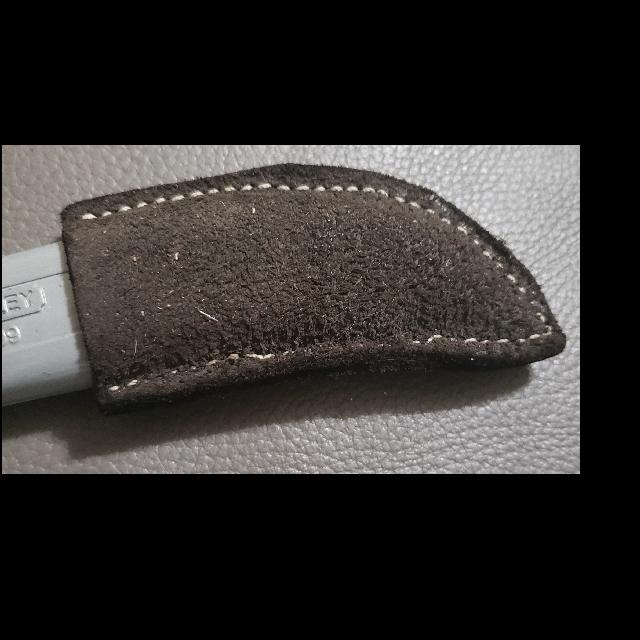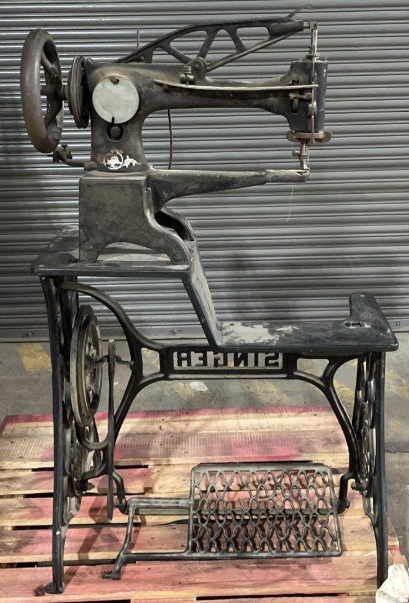-
Posts
1,282 -
Joined
Content Type
Profiles
Forums
Events
Blogs
Gallery
Everything posted by SUP
-
These are ring clamps, normally used by jewelers to hold rings and other items tight while working on them. Amazon.com: KooingTech Ring Clamp, Wire Wrapping Tools, Jewelry Clamp Suitable for Gripping and Fixing Various Small and Delicate Components
-

New Tool Idea - Large Leather Shears - Should I make these for sale?
SUP replied to Stagesmith's topic in Leather Tools
Yes. The type of cutting tool depends on the leather being cut, is it not? I use round knives or my most favorite tool, the fixed blade Stanley knife usually but reach for scissors every so often when cutting leathers that will be cut with scissors. To have a pair that cuts thicker leather will be nice. -

New Tool Idea - Large Leather Shears - Should I make these for sale?
SUP replied to Stagesmith's topic in Leather Tools
There are shears in the market that are large although not the brands known well here. They work well on thinner leathers but they do not work on thick leather, at least none that I have seen. So there is no reason why your shears should not sell well. Best of luck.🙂 -
That's okay. As long as you know that people appreciate your work. 🙂
-
🙂I'm sure your mother will love them. You can see the love you put into making them. The colors you have selected look so beautiful together.
-
That would be the thing to do. You have not mentioned the type of leather on your couch. Vinegaroon only works on unfinished veg tanned leather. Baking soda damages leather more than vinegar, so be careful. You could try those enzymatic cleaners that are available for pet messes to get the stain really clean but spot test first.. After that, there are many leather dye creams available online, on Amazon. They are usually advertised for shoes or bags but work well on anything. I tried them some years ago and the shoes I restored then are still going strong.
-
😅 I guess that is a sign that I need not worry about trying chicken fat on leather. I'm afraid I do not know much about ancient Ireland except for the fact that the society was more advanced and structured and much more respectful of women than society today. I always wondered why they allowed the Anglo Saxon hordes and their sanctimonious attitudes to overcome them. Anyway, I seem to be digressing from the main topic. I am planning to try the various water based conditioners. Sometimes I find that I need one which does not change the color of the leather. I know the Chemical Guys conditioner is good but am looking for others. I have found that with water based conditioners, I need to condition more frequently. Without an occlusive agent, the leather dries faster, I suspect. That is why, if I can condition a set with different water based conditioners, I can get an idea of how long each conditioner lasts before the specific piece of leather needs to be conditioned again My current set, with oils, waxes and fats are still fine and do not need to be treated again.
-
Oh yes! I remember reading about it. Chandlers used to go around to different villages in their carts, making the yearly supply of beeswax candles for the churches and the wealthy. I do not remember which century or country though but it would have been in Europe. The East was completely different in every way. Is that the time when chicken fat would have been used on leathers? Has chicken fat even been used anywhere on leather, anyway? I wonder. Everywhere I read the same thing - It goes rancid fast! If people find rancid coconut oil unpleasant surely they would object to this too? Or, they did not mind the smell, in which case, I come back to my original suggestion that maybe their surrounding smells inured them to the smell of rancid chicken fat. I prefer to think that even if anyone tried, they would have been turned off by the rancidity and never used it again.
-
😅 That puts me in my place. Sorry @fredk no offense was intended. It was different paths of discovery for different cultures and civilizations when people did not travel as much as we do today. We are in such a lucky place in time, having access to all that information now. Those cultures were very advanced - airplanes included, believe it or not. So @AEBL that they knew about soap is not surprising. 🙂 Many scientists have been quietly reading about older civilizations and using that knowledge today, I have heard. Not surprising. Not surprising that they have not given credit to those books either - plagiarism anyone? Coming back to the original thread, people did use plain tallow in lamps, is it not? They were used by the not-so wealthy. The wealthy used beeswax, which was not supposed to be so smelly or smoke as much. I have not tried tallow in lamps but I have read about it. What was used was not the refined tallow we purchase today either. So maybe people had a different attitude to smells from our attitudes today. Needs must, maybe?
-
😄Good to know. although, I don't watch movies, Hollywood or otherwise. I wondered more from the point of view of heat, lack of plumbing and running water and the tendency of people to use bath tubs and toilet paper. Back to the subject, i plan to render the fat from the skin by warming it on a clean pan. Let's see what happens. it is very warm here not and if it putrefies, I will know within a few hours.
-
Yep. My grandmother went through the same - same solution by my grandfather too. Put me off sewing machines for ages.
-

Pirarucu or Arapaima or Amazon bass
SUP replied to SUP's topic in Exotics, Reptiles, Furs and others
It appears that not many have experience working with Pirarucu. When I learn about it, I will post it here for others who might want to know about it as well. -
I have some beautiful pirarucu pieces and am not sure how to use it. The scales are removed and the scale bases remain, in quadrilateral shapes. These shapes have a ridge around them. The ridges are not firm. They are almost filamentous. You can reach under them, to where the scalers were inserted - tiny pockets, as it were. The ridges can tear off easily if I make anything with the leather as it is now. I have seen pirarucu boots and the scale bases and ridges seem pretty firmly in place. If they were not, they would not last long. How do they reach that stage? I have tried Resolene but that gives too much of a shine and does not stick anything in place. Glue maybe, but sticking each scale base in place is going to be tie consuming, not to speak of the damage to the appearance of the leather. I tried that too though. I have heard suggestions of shellac but that will destroy the texture. If anyone has worked with Pirarucu and can guide me on how to use this beautiful, unusual leather, I would appreciate it. Incidentally, Arapaima is a food source in South America and increasingly, being farmed ethically.
-
Check this video from Elk Track Studios. It's on sale right now. https://elktracksstudio.com/products/setting-stones-in-leather?_pos=2&_sid=431e14262&_ss=r
-
I got a similar brown when I was first learning to dye leather and did not use the resist correctly before antiquing. The leather got dyed a uniform dark brown with the antiquing dye. You could try it on some scrap. As far as I can remember, I used Eco-Flo dark brown gel antique. I used a split for the sheath and used the antique finish as a dye precisely to get this brown.
-
You will probably like the look of the old Singer machine I put up a short while ago - a Vintage Singer 29-D-58 Industrial Leather Manual Sewing Machine it says in the listing.
-
Just saw this. Gorgeous old Singer leather sewing machine available in Central California, it appears. I put this up here, in case there is anyone on that side of the country who is interested in old sewing machines. It is a manual one and in need of some TLC. At less that $20.00 too, so probably needs quite a bit of TLC. I'm not selling it, just passing on information that I found online. It is on Shopgoodwill.com
-
Very true. Maybe this and similar posts could be pinned in 'Getting Started' for beginners. Nothing is more encouraging than seeing beautiful work done with a minimum number of tools! I wish I had seen all this when I first started 2 1/2 years ago. Very nice @WalterF, Thank you for showing how much can be achieved with simple tools, skill and imagination. I should have said that first.🙂
-
The method I described is to make 'Chicken oil' which is used as a flavoring agent in far-Eastern cuisine. There are several ways to make it but this seemed to me to be the most suitable for our purpose. Cleaned chicken skin heated in a clean pan until the fats are rendered. Only fried skin remains so I presume the oil will be pure.
-
A big witch's hat (leather, of course) and grubby black robes. Surrounded by mounds of chicken meat and feathers. Think how many I will need to slaughter to get a CAULDRON of fat! All the area cats and dogs and rats surrounding me as well. Hmm... Halloween comes to mind. What an idea.😆 I will probably try to render some chicken fat sometime soon. The next batch of dog food is nearly due. Hope it does not smell too much. The dog food is bad enough.




